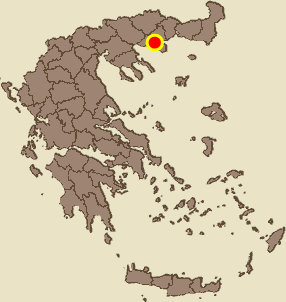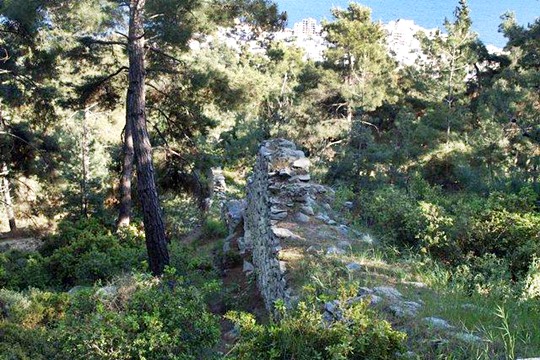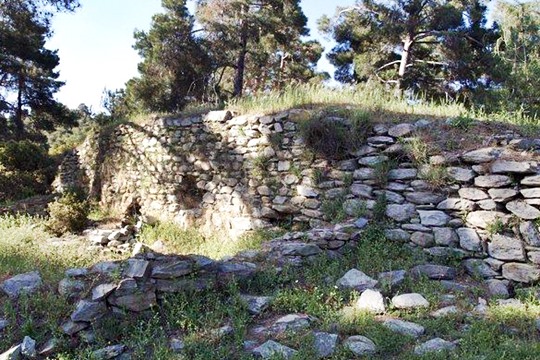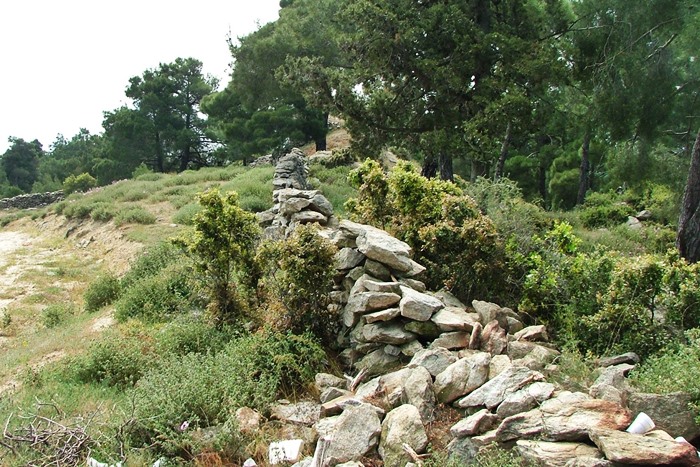Kavala, Kavala, East Macedonia & Thrace
Wall of Christoupolis
| Location: |
| On the hills above the city of Kavala, east of the old hospital |
| Region > Prefecture: |  |
| East Macedonia & Thrace Kavala | |
| Municipality > Town: | |
| City of Kavala • Kavala | |
| Altitude: | |
| Elevation ≈ 195 m |
| Time of Construction | Origin | |
| 1307 | Late-BYZANTINE |
|
| Castle Type | Condition | |
| Cross-Wall |
In Ruins
|
Remains of walls and towers on the hills above the city of Kavala, in the area of the old “Sanatorio”. This is what’s left from a curtain wall that reached from there to the sea and the fortress of Kavala , the old name of which was Christoupolis.
History
The wall was built in 1307 under written instructions by the Byzantine emperor Andronikos II Paleologos. The cause of its construction was the 1306 attempt by the Catalan company to capture the city.
The Catalan company was a group of Catalan, Italian and Aragonese mercenaries which was hired by the Byzantines in 1303 to fight against the Turks. Initially, they proved to be useful, but when the Byzantines failed to pay the agreed fee, they turned against the Greek population. Based in Gallipoli, they started to pillage the towns of Thrace. In 1306, they moved to the west in search of fresh territories to loot. In their march, they attacked and plundered every city in Thrace and eastern Macedonia. Only two places resisted successfully: Thessaloniki and Christoupolis. The medieval chronicle of the Catalan company by Ramon Muntera mentions, in a prideful tone, that only 4 Greek cities escaped plunder: Constantinople, Adrianople, Thessaloniki and Christoupolis. .
The long wall of Christoupolis was built in the shadow of these events. Its purpose was not so much to protect Kavala but rather to impede the Catalans from returning back to Thrace, where they were a threat to the heart of the ailing Byzantine Empire: Constantinople.
The wall blocked the passage from the hills of Kavala to the sea. This was the main passage from the west to Constantinople. There were other forts and towers surveying the passage, but this was the only fortification blocking it completely.
The fortification was used for a relatively short period. In 1391 the Turks conquered Kavala and destroyed completely the city and its fortifications. In 1425, the Turks rebuilt the fortress, but did nothing for the wall which gradually disappeared as the city expanded.
However, some of the towers on the hills, especially the rectangular tower at the very top (not preserved) must have been used as watchtowers by the Ottomans.
Structure, Fortification & Buildings
The length of the wall was ca. 1500m. The fortification was of the open type, i.e. was not encircling a specific point but instead extended from one point in the hills to another at the northern corner of the fortress of Kavala.
It is very likely that the Aqueduct of Kavala (which is preserved today and a trademark of the city) was embedded in the fortification. The fortification consisted of two parallel walls with a gap between them. An unknown number of towers was built along its length.
Nothing is left from the part that was running inside the modern city. In the hills to the north, in the region of the old Hospital (“Sanatorio”) there are remains of the walls in low height and ruins of 4 towers. The biggest tower was the rectangular tower that was at the northern tip of the fortification. It was preserved and visible from the city until recently. Unfortunately it collapsed during a storm in December 2002.
The cylindrical tower that is shown in the pictures above is the only tower still standing. It is a little lower to the south from the collapsed big rectangular tower.
| First entry in Kastrologos: | December 2018 |
Sources
- Dr. Andreas Wolff : Pictures and photographs
- blog MAKIS LIOLIOS - ΜΑΚΡΑ ΤΕΙΧΗ ΚΑΒΑΛΑΣ ΚΑΙ ΚΟΥΛΕΣ (ΓΚΟΛΕΣ). Η ΙΣΤΟΡΙΑ ΠΡΕΠΕΙ ΜΕΙΝΕΙ ΖΩΝΤΑΝΗ
- N. Karagiannakidis & Kyriakos Lykourinos, “NEAPOLIS- CHRISTOYPOLIS-KAVALA. HISTORY OF KAVALA FROM 4500 BC TO OUR DAYS”, Municipality of Kavala, pag.22
- Κωνσταντίνος Τσουρής, ΝΕΑΠΟΛΙΣ - ΧΡΙΣΤΟΥΠΟΛΙΣ - ΚΑΒΑΛΑ / ΔΙΟΡΘΩΣΕΙΣ - ΠΡΟΣΘΗΚΕΣ - ΠΑΡΑΤΗΡΗΣΕΙΣ ΣΤΗΝ ΟΧΥΡΩΣΗ ΚΑΙ ΤΗΝ ΥΔΡΕΥΣΗ, ΑΡΧΑΙΟΛΟΓΙΟΝ ΔΕΛΤΙΟΝ, τόμος 53 (1998), Μέρος Α’ - Μελέτες, Αθήνα 2002, σελ. 408-410
|
|
| Access |
|---|
| Entrance: |
| Free access |
| Other castles around |
|---|
| Castle of Akontisma |
| Wall of Akontisma |
| Fortress of Kavala |
| Acropolis of Filippi |
| Tower of Palia Pyli |
| Castle of Nea Peramos |
| Fortress of Petropigi |
| Yperkalos tower |










